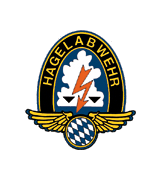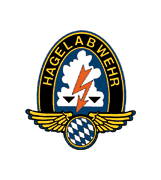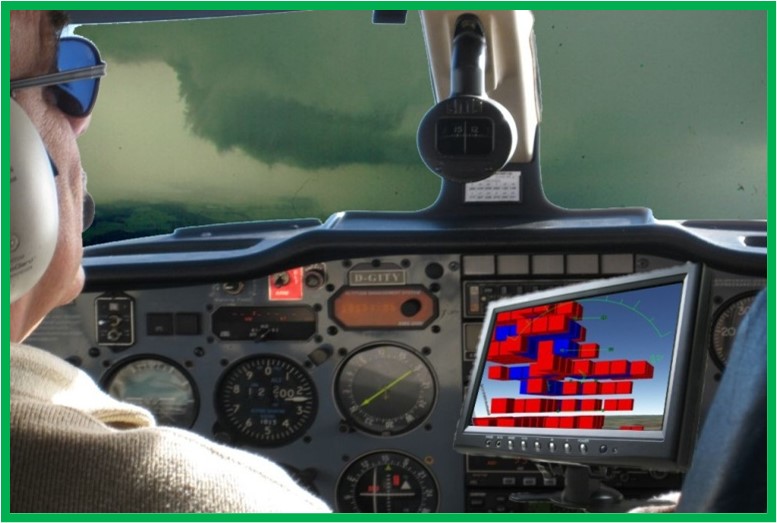RO-BERTA4: Continuation of RO-BERTA
The RO-BERTA project supports the Rosenheim hail defense by processing weather data from the German Weather Service as a "hail navigator" for the pilots.
Project background
The successful collaboration between Rosenheim University of Applied Sciences and the Rosenheim Hail Research Association is set to continue. The first phase began in 2010 and the contract for the research project entitled "RO-BERTA 4" has now been signed at the district administration office and will run until 2028. In the coming years, the effectiveness of hail defense in general and the accuracy of short-term weather forecasts in particular will be investigated.
The collaboration between the hail pilots and Rosenheim Technical University of Applied Sciences began in 2007 with the RO-BERT project. This was the name of the device that collected meteorological data, registered the amount of silver iodide injected into the hail cell and recorded the position of the hail aircraft. The information collected was then combined with ground radar data from the German Weather Service. This made it possible for the first time to visualize the flight path and the hail cell.
A smartphone app was later developed (see "Hagelabwehr" in the Play Store and App Store), which allows all interested citizens to accompany the hail pilots during their missions and also submit weather reports. In 2014, the project won first prize in a satellite navigation competition. Since then, both of the hail pilots' aircraft can be followed live at the same time.
The Rosenheim University of Applied Sciences helps
the hail defense pilots as part of the RO-BERTA project by providing them with a
the form of a "hail navigator", the measurement data
from the German Weather Service (DWD) reliably via a stable radio link to the cockpit.
to the cockpit. Via an app (Android and Apple), users can
can track flights and send weather alerts that can be used to
weather forecast models can be checked and improved. The project
became internationally known when it won the European Satellite Navigation Competition in 2014.
Navigation Competition, see the Wikipedia entry.
Project objective
In addition to the continuous technical improvement of the pilots' computer-aided hail defense equipment, the focus in the focus on the scientific analysis of effectiveness in the coming years. To this end, former student Andreas Bernatzky wrote in 2019 in in his Master's thesis Investigation of the influence of hail defense on hail damage and meteorological data in the district of Rosenheim, several approaches were examined, one of which was was presented in a BR article and showed indications of showed evidence of effectiveness.
However, the approach outlined in the analysis was was limited to very little data and is now to be applied to large amounts of data data, whereby the evaluation methods are to be developed and programmed in MATLAB are to be programmed. Only then can viable statements be made.
Project procedure
In the first project phases RO-BERTA and ROBERTA2, the focus was on equipping focus was on equipping one of the two hail aircraft (GITY) with a communication communication link to the university in order to get the measurement data from the German weather service into the cockpit. In addition, emphasis was placed on processing of the data for the pilot.
ROBERTA3 is now being equipped with the second hail aircraft (GOGO) is now being equipped and the entire data connection is being expanded accordingly. Emphasis is also being placed on methods to assess the effectiveness of hail defense flights.
For the next phase of ROBERTA4, project manager Professor Peter Zentgraf and his students have set themselves several goals: " We want to involve the public even more in hail defense. On the one hand, the apps are to be made more modern and enhanced with a live stream from the hail aircraft. We also want to investigate the possibility of short-term weather forecasting with the help of artificial intelligence in order to start operations earlier if necessary," says Zentgraf. Another project is to make the hardware and software for data transfer from the university to the hail aircraft more robust and low-maintenance.
Innovation
The Innovation in hail control in the RO-BERTA 4 project lies in the outlined cycle of hail warning -> hail control -> hail notification -> model improvement -> hail warning . The result of this cycle is a reduction in hail damage of hail damage throughout the region.
The further development of the research project was also the subject of a visit to the university by a delegation from the German Weather Service (DWD). At the meeting, the reasons for different radar data displays in similar DWD products during a mission in August 2023, during which a severe thunderstorm occurred, were successfully investigated. With the support of the two hail defense pilots present, further opportunities for cooperation were discussed. "By presenting new radar products and the parameters derived from them, the national weather service is helping to optimize the database in ROBERTA. We wish the hail pilots in south-eastern Bavaria a good basis for consultation at all times and good luck with their missions," said Reik Schaab from DWD.

Project lead
Project staff
T +49 (0) 8031 / 805 - 2538 ralf.hager[at]th-rosenheim.de
T +49 (0) 8031 / 805 - 2650 martin.heigl[at]th-rosenheim.de
T +49 (0) 8031 / 805 - 2664 michaela.huber[at]th-rosenheim.de
T +49 (0) 8031 / 805 - 2322 adrian.zeitler[at]th-rosenheim.de


